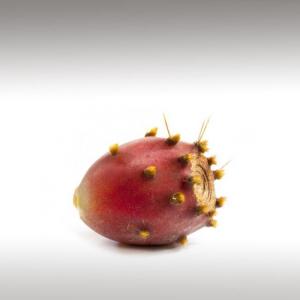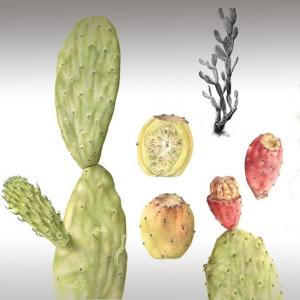
PRICKLY PEAR SEED OIL (OPUNTIA FICUS INDICA) - BASE OILS

BASE / GENERAL DATA
Information submited: October 17, 2017 Modified: May 9, 2018 By: OperaDreamhouse
Botanical Name: Opuntia ficus indica;
Common Method of Extraction: Cold-pressed;
Part Typically Used: Dried seeds;
Color: From pale to medium greenish or greenish yellow appearance;
Consistency: Rich, fatty, silky smooth feel;
Smell: Prickly Pear Seed Oil has a pronounced but pleasant odour, seed oil has a unique smell we would describe as floral, fruity and a sweet honey;
Self life: Cactus Seed Oil is very rich in natural anti-oxidants and has a long shelf-life. Stored out of direct, strong light and heat, cactus seed oil should stay in good condition for up to 18 months;
Common name: Barbary Fig Oil, Prickly Pear Oil or Cactus Seed Oil;
Prickly pear is a genus consisting of about 200 species of cactus. Prickly pears are the fruits of this resistant cactus that are native to Mexico and South America, but that are grown in many areas of the world, including South Africa, Australia, United States of America, Tunisia and it also grows in the desert in southern Morocco.
Prickly Pear ( Barbary Fig ) Seed oil is a natural oil extracted from the seeds of the fruit of the Opuntia Ficus Indica Cactus. This cactus will grow up to 2 meters in height and needs little water.
The Opuntia Ficus Indica Cactus produce beautiful bright yellow and pink flowers in the spring which produce fruit by the end of summer.
To make Cactus seed oil farmers harvest the ripe cactus fruit around the end of July. When ripe, the ovoid Cactus fruit is slightly soft, 5 to 8 cm in length and has a green to reddish purple colour.
It is the Cactus fruit that contains a reddish, greenish, yellowish sweet pulp full of black seeds. One other thing to note about prickly pear seeds is that although Cactus pears carry an average of 150 - 300 seeds each, only a tiny amount of oil can be extracted from each seed.
The seeds are separated from the fruit and dried. Barbary Fig oil is cold pressed from these seeds. Prickly pear Cactus seeds are hard and woody and contain less than 5% oil. This is why 1000 kilos of fruit yields just 30 Kilos of seeds. Each 30 kilos of Cactus seeds makes just one litre of pure oil.

SPIRITUAL PRACTISES DATA

MEDICINE / HEALTH DATA
Information submited: October 17, 2017 Modified: May 9, 2018 By: OperaDreamhouse
Cold pressed and organic Prickly Pear Cactus Seed oil is produced from Cactus seeds alone. These seeds produce very little oil but the oil obtained has a wide range of nutrients. It has 150% more anti aging and anti oxidant Tocopherol than even Argan oil.
The oil is rich in minerals and has over 80% omega - 3 and omega - 6 fatty acids. It is fatty acids that repair and generate tissue within the body helping with the natural healing process.
Studies also found Prickly Pear Seed oil to be exceptionally rich infatty acids, particularly in linoleic acid.
One study measured between 61,4 - 68,9% linoleic, 12,38 - 16,51% oleic, and 11,44 - 15,89% palmitic acid. In yet another study, of the total fatty acids present in the seed oil, 70,3% consisted of linoleic, followed by 16.7% oleic. With regard to its lipid profile, Opuntia Seed oil was considered exceptionally rich and comparable with Grape Seed oil.
One study measured between 61,4 - 68,9% linoleic, 12,38 - 16,51% oleic, and 11,44 - 15,89% palmitic acid. In yet another study, of the total fatty acids present in the seed oil, 70,3% consisted of linoleic, followed by 16.7% oleic. With regard to its lipid profile, Opuntia Seed oil was considered exceptionally rich and comparable with Grape Seed oil.
A 2014 study found that the Prickly Pear Seed contained 403 mg/kg of Vitamin E mostly in the form of γ-tocopherol. Some studies considered the tocopherols in the seed oil to be capable of making the seed oil quite stable.
A German study focused on topical treatments containing phytosterols. The results indicated that phytosterols not only stopped the slow-down of collagen production, but they actually encouraged new collagen production. Thus, the researchers suggested that phytosterols can reverse the effects of aging and may be useful additions to anti-aging products.
Traditional Moroccan medicine also uses whole prickly Pear fruits for their hypoglycemic and hypolipidemic actions. Opuntia Ficus Indica is used in other regions as laxative, anti-inflammatory, or against diarrhoea.
Prickly Pear Seed oil reviews also reveal it is also an antacid, astringent, antidermatosic, emollient, antiseptic, vulnerary, analgesic, expectorant, antiviral, sedative and antioxidant.
Prickly Pear Seed oil reviews also reveal it is also an antacid, astringent, antidermatosic, emollient, antiseptic, vulnerary, analgesic, expectorant, antiviral, sedative and antioxidant.

BEAUTY / COSMETICS DATA
Information submited: October 17, 2017 Modified: May 9, 2018 By: OperaDreamhouse
Intensive anti aging treatment for lines and wrinkles on the face;
Repair damaged hair;
Reduce dark circles under the eyes;
Rich moisturiser for dry skin;
Calms inflamed, red or blotchy skin;
Reduces dark skin pigmentation and marks;
Restores skin elasticity and firms skin;
Repair damaged hair;
Reduce dark circles under the eyes;
Rich moisturiser for dry skin;
Calms inflamed, red or blotchy skin;
Reduces dark skin pigmentation and marks;
Restores skin elasticity and firms skin;
Cactus Seed oil is a rich, fatty oil suitable for most skin types including those with sensitive skin. Perfect for deep hydration and protection of the face and hair in any environment.
Cactus Seed oil has 150% as much Vitmain E as Argan oil, additional minerals, plant sterols, Betalains that help with lightening dark marks and Vitamin K for “spider veins” and dark circles under the eye.
With large amounts of linoleic acid, Vitamin E, phytosterols, and polyphenols, Prickly Pear Seed oil stimulates healthy cell production and turnover, provides protection, and helps skin retain moisture. These components make the oil an extremely rich and skin-nourishing oil. It soothes, hydrates, and reduces inflammation that can damage collagen, and it can prevent skin aging and wrinkles.
Barbary Fig Seed oil can be used as a treatment for dry hair and scalp. Use small amounts and work into target areas of damaged hair. Combine Barbary Fig Seed oil with Argan oil for hair treatments to boost shine and improve hair condition.
The Berber women have for centuries used this oil as a secret beauty regime.

FOOD / COOKING DATA
COMMENTS
No comments.



